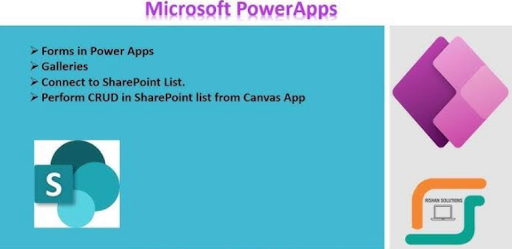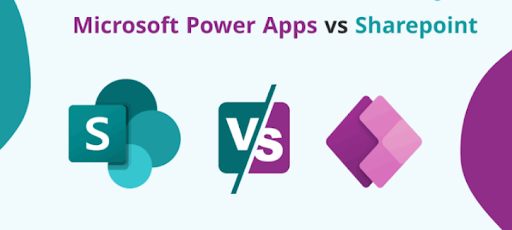Thrive has spent significant time and effort over the past few years developing and delivering automated enterprise workflow solutions that take advantage of the features of the Microsoft Power Platform. We can speed up our customers’ digital transformation with the aid of the platform’s low-code functionalities by using tools like PowerApps, Power Automate, as well as Power BI.
However, it may be desirable to build the form utilizing the SharePoint Framework (SPFx) as the needs get sophisticated. This is especially the case when dealing with large amounts of data, a time-sensitive form load, or intricate user interface specifications. SPFx is a development-heavy platform, but with the right know-how, you can quickly whip up custom forms that provide a more elegant solution.
Let’s take a deeper dive at Microsoft’s PowerApps vs. Sharepoint complements one another to help organizations improve the customer service they offer. What’s the best choice here? Keep reading as we do a comparison between Microsoft’s PowerApps and Sharepoint.
Table of Contents
Table of Contents
- Define Sharepoint
- Define Microsoft Powerapps
- In what ways do Sharepoint and Microsoft’s PowerApps work together?
- What are the advantages of Integration of PowerApps with Sharepoint?
- How PowerApps and Sharepoint work together to your advantage?
- What is the Distinction between Microsoft Power Apps vs Sharepoint?
- Distinctive Features of SharePoint and PowerApps
- Summary
- Conclusion
Define Sharepoint
Businesses often utilize Microsoft SharePoint as a web development platform. It provides a protected space for storing, organizing, sharing, and accessing information from any gadget. All you need is a web browser like Chrome, Firefox, Microsoft Edge, or Internet Explorer.
Define Microsoft Powerapps
Apps, products and services, connectors, as well as a data platform are all part of Power Apps, which allows you to build apps specifically for your business. With Power Apps, you can build custom business applications in a short amount of time that integrate with data from a wide variety of cloud and on-premises services, such as Microsoft 365, SQL Server, SharePoint, Dynamics 365, as well as others.
In what ways do Sharepoint and Microsoft’s PowerApps work together?
In addition to existing independently from SharePoint, with Sharepoinft Course, learn how the Microsoft 365 bundle includes Power Apps. Since Power Apps can communicate with a wide variety of databases, you may use it to retrieve and save information of any SharePoint list, library, or One Drive. It also connects to the data in SharePoint lists and works seamlessly with the SharePoint mobile devices and the web interfaces.
What are the advantages of Integration of PowerApps with Sharepoint?
By communicating with several databases, Power Apps may retrieve and save information in any SharePoint list, library, or even One Drive. You can get more done in the SharePoint environment with the help of the PowerApps SharePoint integration services, which is great for your company. You can use Power Apps to copy and save information from any SharePoint list, libraries, or even One Drive.
Let’s take a look at some of integration’s benefits:
- If you’ve built your business applications on the SharePoint Power Platform, you may tap into its massive troves of data to make more informed decisions.
- SharePoint online power applications provide access to Power Apps, allowing you to stay abreast of any and all company information from anywhere, at any time.
- Additionally, you might automate your repetitive business procedures owing to Power BI’s interface with PowerApps as well as SharePoint Online.
- Integrating Power BI with Microsoft SharePoint applications enables dashboard embedding of visual analytics and data visualization. A consolidated display of graphs and statistics might help you make snap decisions.

How PowerApps and Sharepoint work together to your advantage?
- Developing on the Power platform reduces future maintenance and upkeep work for SharePoint.
- SharePoint’s strong interaction with all of the Power Platform features makes it easier to design business apps as well as integrate them into SharePoint.
- Provides the means to put into action, within the Microsoft Cloud, an IT strategy that leverages the best of Microsoft’s collaboration plus content-management tools, Teams and SharePoint, and Microsoft’s application-development platform, Power Platform.
- Cooperation with Citizen programmers who may assist the apps in SharePoint is conceivable when constructing web power apps. As a result, the company’s culture of volunteer software engineers will improve.
- While using Apps, users can stay in the comfortable and familiar SharePoint environment.
What is the Distinction between Microsoft Power Apps vs Sharepoint?
SharePoint Online is a cloud-based platform with a wide variety of purposes, but its primary functions are enterprise managing content, managing documents, business intelligence, as well as team collaboration. The Power Platform is a set of low-code and no-code tools that lets its customers create their own software solutions, such as mobile apps (Power Apps), chatbots (Power Virtual Agents), business intelligence (Power BI), and robotic process automation (Power Automate). Dataverse is an infrastructure for managing and sharing data.
Distinctive Features of SharePoint and PowerApps
-
Incorporate:
Integrating Microsoft’s Office 365, Outlook, as well as OneDrive with SharePoint is a breeze. These products as well as other external data sources are able to be combined with PowerApps.
-
Adaptability:
It is possible to make adjustments to SharePoint, although the platform has limitations because to its pre-built features. PowerApps, on the other hand, allows for extensive personalization and adaptability, letting users build apps that specifically address their businesses’ needs.
-
Cost:
SharePoint’s per-user pricing is the same as that of the rest of Office 365. However, PowerApps’ pricing is more flexible, with plans suitable for both individual and enterprise use.
-
Complication:
With Sharepoint Course, learn how SharePoint can be complicated, especially for users who lack technology trend expertise. On the other hand, PowerApps is meant to be simple to use and accessible to a bigger audience.
-
Practical:
While PowerApps serves as a programming environment for generating unique corporate apps, SharePoint is primarily a document management and sharing platform.
One of the primary distinctions between PowerApps vs SharePoint you will learn with Sharepoint Course is the level of sophistication. SharePoint is a powerful tool for document management and communication, but it may be difficult to set up and use, particularly for users who are not technically savvy. On the other hand, PowerApps is meant to be simple to use and available to a bigger audience. It makes it a great choice for companies that ought to rapidly create custom business apps with little to no involvement from IT departments.
SharePoint and PowerApps have been strong tools that can be utilized to boost productivity and cooperation in the office, but they offer certain fascinating contrasts that should be explored further.
It’s also interesting to compare SharePoint and PowerApps’ approaches to customisation. SharePoint’s adaptability is constrained by the default features it provides. PowerApps, on another hand, is highly adaptable and customizable, letting businesses build apps that meet their specific requirements. This makes it a terrific option for firms who have to create distinctive answers to particular business difficulties.
With Sharepoint Course, learn how PowerApps allows you to access data from a wide variety of sources, including Dynamics 365, SharePoint, or external data sources. This paves the way for companies to create bespoke apps that integrate data from several sources, boosting efficiency and collaboration across the board.
Summary
Get some Power Apps if…
- You probably won’t need to keep more than 5,000 files.
- Form processing time is not a major factor.
- You haven’t included any sophisticated repeating sections and business logic in your forms, so they’re easy to fill out.
- You lack sophisticated validation and conditional logic.
- After submission, your forms are not required to go anywhere specific.
- Designing for compatibility with a wide range of browser types isn’t mandatory.
- You also have experts who can manage and alter the most fundamental features and structures.
Use the SharePoint Framework if…
- It’s crucial that forms load and navigate quickly.
- There is intricate logic and/or user interface design required.
- You either need to relocate the form to different sites or support the whole Software Development Lifecycle.
- For optimal compatibility across browsers, you’d like full reign over the adaptive layout.
- Integrating easily with Microsoft Teams or SharePoint is crucial.
Conclusion
Finally, by integrating Power Apps in SharePoint, with Sharepoint Course, learn about the application that may take advantage of state-of-the-art SP functionalities like search management, smart intranets, and AI-powered content. When put together, they can improve workplace communication, facilitate more deliberate decision-making, and enhance operational effectiveness.





п»їlegitimate online pharmacies india https://indiaph24.store/# Online medicine order
indianpharmacy com
http://lisinopril.network/# lisinopril 5 mg for sale
https://finasteride.store/# cheap propecia prices